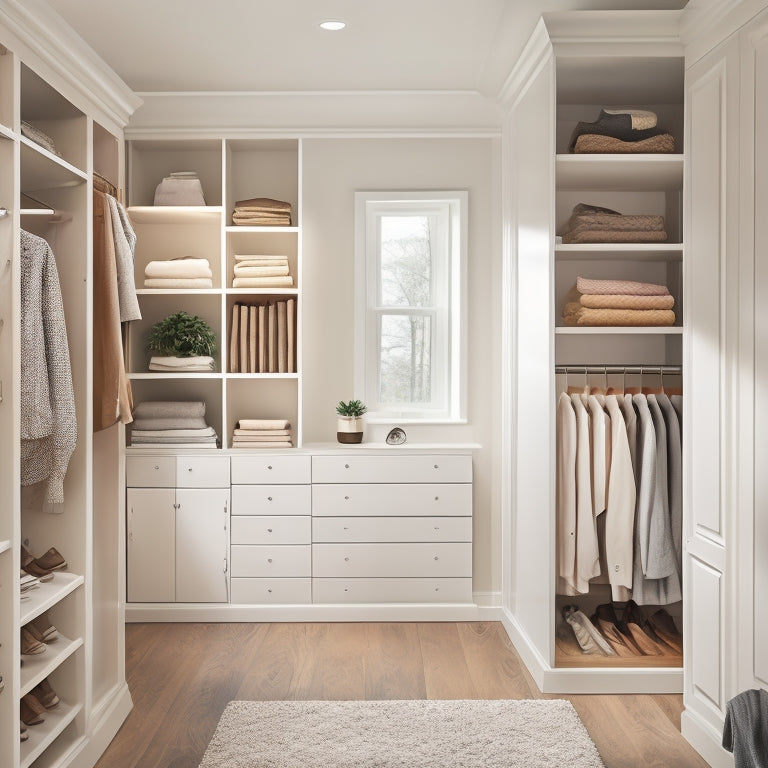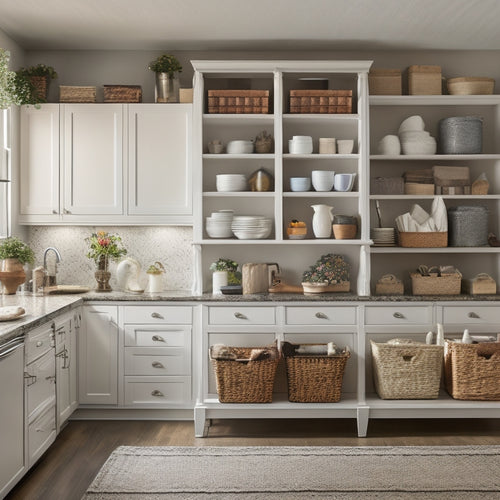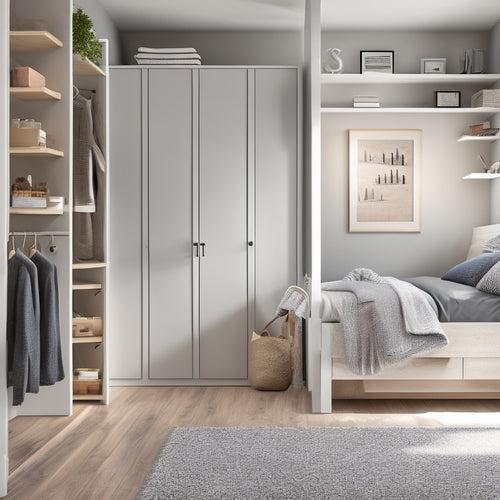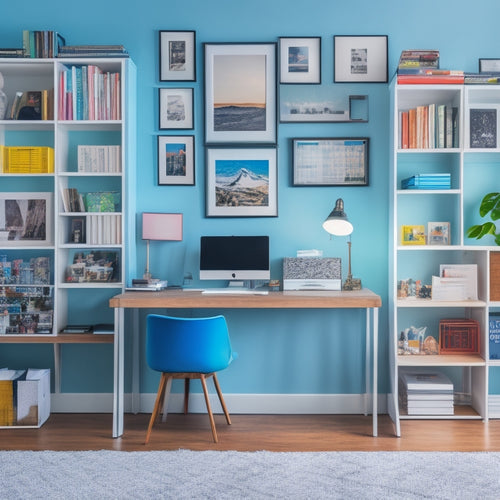
Optimize Your Small Closet With Custom Organizer Plans
Share
You're ready to turn your cramped closet into a haven of organization and style. Start by maximizing storage in every nook and cranny, using double rods, shelves, and baskets to make the most of your vertical space. Next, take precise measurements of your closet's unique shape and available wall space to inform your custom design. With your plan in hand, select materials that fit your budget and aesthetic, from solid hardwood to budget-friendly MDF. As you bring your vision to life, you'll discover a space that not only looks amazing but also streamlines your daily routine - and there's more to explore.
Key Takeaways
• Assess your closet space by noting its shape, available wall space, and floor space to determine the best storage solutions.
• Choose materials for your custom organizer that fit your budget, lifestyle, and personal style, considering factors like moisture resistance and aesthetic variations.
• Design your custom organizer around your daily routines, hobbies, and personal style to prioritize storage needs and accommodate statement pieces.
• Incorporate multifunctional elements like double-duty shelves, fold-down tables, and hidden compartments to maximize storage and functionality.
• Anchor shelves securely and consider professional assistance if needed to ensure a successful installation of your custom organizer.
Maximizing Storage in Tight Spaces
By strategically allocating every inch of your small closet's real estate, you can squeeze in up to 30% more storage capacity, making the most of its compact footprint.
To achieve this, implement space hacks like double rods, shelves, and baskets. These storage solutions will help you optimize your closet's vertical space, keeping floors and surfaces clutter-free.
Consider installing a pegboard or hooks for hanging belts, hats, or bags, freeing up shelf space for folded items. Use stackable bins and baskets to store items like socks, accessories, or out-of-season clothing.
Label each container to maintain a sense of organization and make it easier to find what you need. By incorporating these clever storage solutions, you'll be able to fit more into your small closet, making the most of its limited space.
With a little creativity and planning, you can transform your closet into a functional and efficient space that makes your daily routine easier.
Measuring Your Closet's Dimensions
As you stand in your closet, take a moment to survey the space.
You're about to capture its dimensions, so make sure to note the length, width, and any obstructions like windows, doors, or plumbing fixtures.
With your measuring tape at the ready, you'll create an accurate blueprint of your closet's unique shape.
Closet Space Dimensions
What're the exact dimensions of your closet, and have you ever stopped to think about how they impact your storage and organization needs? Understanding your closet's dimensions is important in creating a custom organizer plan that maximizes your space.
Take a closer look at your closet's shape and consider the following factors:
-
Closet Shape: Is your closet a perfect square, a narrow rectangle, or an L-shape? This will influence the type of storage solutions you can install.
-
Corner Utilization: Are there any dead corners that can be optimized with carousel units or shelves?
-
Wall Space: How much wall space do you have available for shelves, hooks, or rods?
-
Floor Space: Is the floor clear for a dresser or shelving unit, or are there any obstructions?
-
Ceiling Height: Can you take advantage of vertical storage with tall shelves or storage units?
Measuring Accuracy Matters
To get a precise picture of your closet's dimensions, grab a tape measure and carefully record the length, width, and height of each wall, making sure to account for any obstacles like windows, doors, or molding that might affect your storage plans. Don't rush through this process – measurement mistakes can lead to costly mistakes down the line. Take your time, and double-check your measurements to guarantee accuracy.
As you measure, visualize your closet's layout, noting any unique features or challenges. Are there any awkward corners or tight spaces that will require special consideration? Use precision tools, like a laser level or a digital tape measure, to get accurate readings. Don't rely on rough estimates or guesswork – every inch counts when designing a custom organizer system.
Choosing the Right Materials
As you envision your dream closet, you're probably thinking about the materials that'll bring it to life.
You'll want to select materials that not only fit your style but also meet your functional needs and budget.
From wood type to durability and cost, you'll need to weigh your options carefully to create a space that's both beautiful and functional.
Wood Type Considerations
You're likely pondering three primary wood types for your custom organizer: solid hardwood, engineered wood, and medium-density fiberboard (MDF), each with its unique characteristics and benefits.
When it comes to solid hardwood, you'll appreciate the richness and warmth it brings to your closet space. Engineered wood offers a cost-effective alternative without sacrificing too much in relation to aesthetics. MDF, on the other hand, provides a smooth surface ideal for painting or staining.
Here are some key factors to keep in mind when selecting your wood type:
-
Aesthetic Variations: Different wood types offer distinct graining patterns, from the prominent striations of oak to the subtle, wavy lines of maple.
-
Graining Patterns: Take into account the direction and intensity of the graining patterns to ensure they complement your closet's design.
-
Budget: Engineered wood and MDF tend to be more budget-friendly than solid hardwood.
-
Moisture Resistance: If your closet is prone to humidity, consider wood types with natural resistance to moisture, like cedar or cypress.
-
Color Versatility: Some wood types, like birch or beech, take stains and paints exceptionally well, allowing for greater color flexibility.
Material Durability Factors
With your wood type selected, it's time to contemplate the material durability factors that'll guarantee your custom organizer stands up to the demands of your daily routine and the unique conditions of your small closet.
You'll want to think about materials that can withstand the humidity and temperature fluctuations that come with the changing seasons. Look for materials with high moisture resistance to prevent warping, cracking, or discoloration. Weather adaptability is essential, especially if your closet is prone to dampness or extreme temperatures.
For instance, you may opt for materials with water-repellent coatings or treatments that can withstand exposure to moisture. Additionally, consider materials with built-in UV protection to prevent fading or discoloration from direct sunlight.
Budget-Friendly Options Available
Your budget-conscious quest for the perfect custom organizer begins with exploring cost-effective materials that don't compromise on functionality or style. You don't have to break the bank to achieve a stylish and functional closet. Instead, consider the following budget-friendly options:
-
Plywood shelves: A cost-effective alternative to solid wood, plywood shelves provide a sturdy surface for storing your belongings.
-
MDF boards: Medium-density fiberboard is a budget-friendly option for creating custom shelves and cabinets.
-
Repurposed materials: Think outside the box and get creative with DIY alternatives like using old pallets or crates to create unique storage solutions.
-
Melamine shelves: A type of engineered wood, melamine shelves offer a durable and affordable option for your custom organizer.
-
IKEA hacks: Thrifty solutions can be found by repurposing IKEA products to fit your custom organizer needs.
Designing for Your Lifestyle Needs
As you envision your ideal closet space, consider how your daily routines, hobbies, and personal style will shape the custom organizer plan that's right for you. Think about your personal priorities: do you need ample storage for shoes, or perhaps a designated area for accessories?
Your daily routines will also play a significant role in determining the layout of your closet. For instance, if you're a busy professional, you might want to prioritize a section for quick-grab work essentials. On the other hand, if you're an avid athlete, you may require extra storage for sports equipment.
As you reflect on your lifestyle, imagine the flow of your closet space. Visualize yourself moving through the area, effortlessly accessing the items you need. Consider the types of clothing you wear most frequently and how you can optimize storage for those items.
Perhaps you have a penchant for statement pieces or a weakness for trendy shoes – your custom organizer plan should accommodate these personal touches. By considering your unique needs and habits, you'll create a space that not only looks amazing but also functions in harmony with your daily life.
Incorporating Multifunctional Elements
Step into a closet that's a masterclass in multitasking, where every element serves a dual purpose, and cleverly designed features maximize storage while minimizing clutter. You're about to discover the key to a space that's both functional and stylish. By incorporating multifunctional elements, you'll access the full potential of your small closet.
Here are some genius ways to get the most out of your space:
-
Double-duty shelves: Install shelves with built-in drawers or cabinets underneath to store items like socks and accessories.
-
Fold-down tables: Add a fold-down table that can serve as a workspace or a spot to lay out outfits.
-
Hidden compartments: Incorporate hidden compartments behind shelves or inside cabinets to stash valuable items or out-of-season clothes.
-
Space savers: Invest in stackable bins or baskets that can be easily labeled and accessed.
-
Step stools with storage: Choose a step stool that doubles as a storage container for items like bags or shoes.
Installing Your Custom Organizer
With a solid plan in place, you're ready to bring your custom organizer to life by anchoring shelves, securing rods, and fitting components together like a puzzle. This is where the DIY magic happens, but it can also be a challenging phase. Be prepared to tackle DIY challenges like measuring twice, cutting once, and guaranteeing a level installation.
If you're not comfortable with power tools or complex assemblies, consider seeking professional assistance to avoid frustrating setbacks.
As you begin installing your custom organizer, visualize the final result to maintain motivation. Start with the base components, like shelves and drawers, and work your way up. Use a level to make sure everything is straight, and don't be afraid to ask for help if needed.
Frequently Asked Questions
Can I DIY a Custom Closet Organizer or Do I Need a Professional?
'If you're handy and have basic carpentry skills, you can DIY a custom closet organizer, but if you're short on time or have complex design needs, consider hiring a pro to guarantee a stress-free, budget-friendly outcome that suits your style.'
How Do I Deal With Awkward Corners and Uneven Closet Walls?
You're solving a puzzle, trying to fit pieces together, as you deal with awkward corners and uneven walls. Corner shelves can be your savior, and understanding wall angles is key to creating a seamless, functional space that flows like a harmonious dance.
Are Custom Closet Organizers Only for Walk-In Closets or Can They Be for Small Reach-In Closets?
You'll be relieved to know that custom closet organizers aren't just for spacious walk-ins; they can also work wonders in small reach-in closets, skillfully maneuvering closet constraints to create a space-savvy haven that maximizes every inch.
Can I Incorporate a Laundry Station or Desk Into My Custom Closet Design?
You can creatively incorporate a laundry nook or desk integration into your custom closet design, maximizing space with clever fold-down or slide-out features that seamlessly blend functionality with stylish storage solutions.
How Long Does It Typically Take to Install a Custom Closet Organizer System?
"Are you wondering how soon you'll be enjoying your dream closet? Typically, the installation timeline spans 2-5 days, depending on the project's phases, which include design, production, and installation - you'll be organizing in no time!"
Related Posts
-

3 Essential Tips to Boost Home Storage Capacity
You're one step away from freeing yourself from clutter chaos! To boost your home storage capacity, start by purging ...
-

7 Clever Hacks for Small Bedroom Storage
You're about to discover the secret to revealing generous storage in even the smallest of bedrooms. Start by maximizi...
-

Top Digital Tools for Home Organization Success
To achieve home organization success, you'll want to tap into the power of digital tools. Start with decluttering and...


